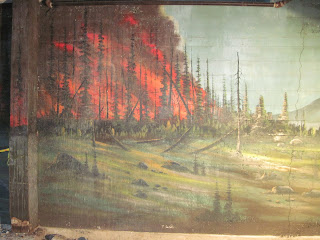When we were told to allow two hours for a walking tour of this city we were surprised. It is a small port city, surely it would not take two hours to see everything. Don, from Heritage Tours, did have plenty to say about his fair town. It was at the Visitor's Center where we got connected up with him. Initially he sat us down to explain the city's major building project of 1914. Some of the streets of the town, located at the bottom of a hill, were constantly being flooded and having problems of sewage coming back into the area when the tide came in. It was necessary to elevate those streets, and that project was completed in six months with all the townspeople working 24/7 to complete it. Concrete walls were poured and then soil and water were shot with cannons down from the hills to fill in the streets between the walls. Any future buildings constructed along those streets had to be put up on wooden piers. There is a mural on one of the town's buildings which shows the whole construction process quite well. After thirty minutes of getting all the details from Don I was getting quite sleepy and was thankful when he announced that it was time to start our tour of the town.
Many of the town's original buildings were torn down except for three which were jacked up to street level. One of those buildings has remained a family shoe store for the past 100 years. It's owner, the fourth generation of his family to sell shoes, has restored many of the original features of the building. Below is a mural on an outside wall of the building.
Interestingly enough, that building may have been a family shoe store, but in the early 1900s the upstairs rooms were used as a brothel. The town back in those days had a lot of sailors and loggers coming in for relaxation and fun. Brothels were in high demand. The owner has restored those rooms to look like what they did back at that time. Don showed us many interesting details of those upstairs rooms- like the peep hole where the madam could look through and check out prospective customers, and the trap door from the poker room where the clientele could climb to the roof and flee any law officials entering the building.
The main attraction of the town is its underground rooms, and there are not that many presently. Over the years the owners of the buildings filled in their underground area with basements. Utility companies put in wiring and plumbing. Those sections of the underground are now inaccessible. Don pleaded for some of that area to be kept open for historical purposes. One underground section used to be a miniature golf course in the early 1900s. Below is a mural which was found on a wall there. It depicts a fire which had occurred at that time in a local forest.
Our Port Angeles tour did take over two hours, and then some. Don had many stories to tell of its history. He has been doing these tours for quite some time and occasionally he will get someone on his tours who once lived in the town. From these people he has been collecting additional town history.




No comments:
Post a Comment